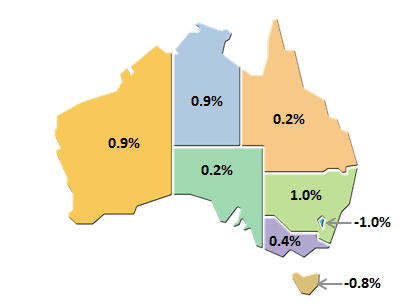MAIN FEATURES STATE FINAL DEMAND CHAIN VOLUME MEASURES
 |  | Seasonally adjusted |
 |  | New
South
Wales | Victoria | Queensland | South
Australia | Western
Australia | Tasmania | Northern
Territory | Australian
Capital
Territory | Australia(a) |
 |  | % change
Jun 17 to
Sep 17 | % change
Jun 17 to
Sep 17 | % change
Jun 17 to
Sep 17 | % change
Jun 17 to
Sep 17 | % change
Jun 17 to
Sep 17 | % change
Jun 17 to
Sep 17 | % change
Jun 17 to
Sep 17 | % change
Jun 17 to
Sep 17 | % change
Jun 17 to
Sep 17 |
|
| Final consumption expenditure |  |  |  |  |  |  |  |  |  |
 | General government | 1.7 | 0.1 | 0.9 | -0.3 | -1.6 | -3.4 | 1.5 | -4.2 | 0.2 |
 | Households | 0.4 | 0.2 | - | -0.3 | 0.1 | -0.6 | -0.3 | -0.4 | 0.1 |
| Gross fixed capital formation |  |  |  |  |  |  |  |  |  |
 | Private | 1.4 | 0.7 | 0.8 | 113.0 | 4.4 | 3.0 | 0.7 | 0.2 | 4.5 |
 | Public | 4.6 | 3.2 | -3.1 | -63.1 | 2.0 | -0.6 | 9.7 | 13.2 | -7.5 |
| State final demand | 1.0 | 0.4 | 0.2 | 0.2 | 0.9 | -0.8 | 0.9 | -1.0 | 0.6 |
|
| - nil or rounded to zero (including null cells) |
| (a) Australia estimates relate to Domestic final demand. |
SEPTEMBER QUARTER
Summary Comments
Australia
- Australian domestic final demand increased 0.6% in the September quarter 2017. State final demand increased in all states except for Tasmania and the Australian Capital Territory.
STATE FINAL DEMAND, Quarterly - Volume measures
: Seasonally adjusted

New South Wales
- New South Wales' state final demand increased 1.0% in the September quarter following an increase of 0.5% in the June quarter. There was broad growth across consumption and capital investment in NSW. Government final consumption expenditure and private gross fixed capital formation were the largest contributors to growth, driven by non-dwelling construction. Growth in public gross fixed capital formation was driven by the general government sector. Household final consumption expenditure also contributed solidly to growth.
Victoria
- Victoria's state final demand increased 0.4% in the September quarter and follows a 1.5% increase in the June quarter. Public and private gross fixed capital formation contributed strongly to growth, along with household final consumption expenditure. The increase in private gross fixed capital formation was driven by non-dwelling construction but was offset by a fall in dwellings. As in New South Wales, the increase in public gross fixed capital formation was driven by the general government sector. Government final consumption expenditure continued to grow in the September quarter.
Queensland
- Queensland's state final demand increased 0.2% in the September quarter and follows a 1.0% increase in the June quarter. Government final consumption expenditure and private gross fixed capital formation were the largest contributors to growth, driven by national final consumption expenditure and non-dwelling construction respectively. Public gross fixed capital formation was a strong detractor from growth, driven by both public corporations and the general government sector. Household final consumption expenditure detracted slightly from growth.
South Australia
- South Australia's state final demand increased 0.2% in the September quarter and follows a 0.7% increase in the June quarter. Private gross fixed capital formation increased strongly in the September quarter with growth exhibited in dwellings and machinery and equipment. The magnitude of the growth was affected by a transfer in the June quarter of the recently completed Royal Adelaide Hospital from private to public sector ownership. Public gross fixed capital formation showed a fall in the September quarter due to the transfer. Total final consumption expenditure detracted from growth for the quarter, spread across both household and government consumption.
Western Australia
- Western Australia's state final demand increased 0.9% in the September quarter and follows an upwardly revised 0.4% increase in the June quarter. The rise in the September quarter was driven by a strong increase in private gross fixed capital formation, which in turn was driven by non-dwelling construction and machinery and equipment. Public gross fixed capital formation increased over the quarter driven by the general government sector. Household final consumption expenditure also grew, albeit modestly, but government final consumption expenditure detracted from growth.
Tasmania
- Tasmania's state final demand decreased 0.8% in the September quarter and follows a rise in the June quarter of 0.2%. Government final consumption expenditure was the single largest detractor from growth, driven by state and local expenditure. Household final consumption expenditure and public gross fixed capital formation also detracted from growth. Private gross fixed capital formation increased, driven by machinery and equipment and dwellings, offset by a fall in non-dwelling construction.
Northern Territory
- Northern Territory's state final demand increased 0.9% in the September quarter following a decrease of 1.1% in the June quarter. The largest contributors to growth were public gross fixed capital formation and government final consumption expenditure. Private gross fixed capital formation also contributed strongly to growth due to a large increase in non-dwelling construction. Household final consumption expenditure was the only major component to fall over the quarter.
Australian Capital Territory
- Australian Capital Territory's state final demand decreased 1.0% in the September quarter following a 1.0% increase in the June quarter. Government final consumption expenditure drove the fall, in turn driven by national final consumption expenditure. Household final consumption expenditure also fell. Public gross fixed capital formation was a strong contributor to growth, with increases across both public corporations and the general government sector. Private gross fixed capital formation increased modestly over the quarter with rises in dwellings and non-dwelling construction being offset by a fall in machinery and equipment.
 Quality Declaration
Quality Declaration  Print Page
Print Page
 Print All
Print All